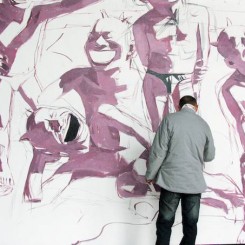YM: I don’t feel “close” to them. I am not like some artists, who look upon their work and feel it’s good. I have a strange feeling when I finish a painting, I am not ‘involved’ in it — there is still that degree of distance, and I feel like an observer.
IW: Each time you paint another of these visages, what is your sensation? It is purely practical, these days, marking out that same expression? Has the force of repetition had an effect on you, over time?
YM: Now, still, I am very excited when I paint this image. Sometimes I ask myself whether it’s because I am still not very good at it — sometimes it troubles me, I don’t know why. Maybe from another point of view it’s just that I am still ambitious and slightly nervous. It is not an easy habit, at any rate.
IW: Does a growing multitude of smiling faces — augmenting with every new piece —simply reflect the original conception of the idea and the feeling they convey?
YM: Maybe the repetition reflects a kind of honest attitude. It might be not unlike religion, wherein icons are repeated over and over again. The more there are, the more affirmative it could be, and a clearer reflection of an original ambition — becoming engrained.
IW: Is that why religious iconography is interesting for you? Your last exhibition at Pace Beijing was entirely based on Christian imagery.
YM: I think it is related, but in an unconscious way. I am still thinking about creating some works relating to Buddhism, but this isn’t ready yet.
IW: Your smiling faces make a statement — albeit one difficult to clearly define — about how people behave and are feeling in relation to their socio-political environment, and whether they fully understand it or not. Do you feel this expression is still apt now? Has there been any change?
YM: I cannot give up this expression because it is still unfolding, and I need to complete it by repeating the image. Maybe there has been some slight change in society, but relative to the broader picture of history, this change is very small.
IW: So the faces you depict and the expression you have chosen is not necessarily bound to the situation here, but is symptomatic of questions for humanity in general?
YM: Yes. It is limiting to approach these problems only in the context of contemporary China.
IW: Have you heard much feedback about the Cartier exhibition?
YM: The exhibition is more about the smiling face. There are some works there from the Maze and Landscape without People series, but when you put these alongside the smiling faces, people cannot switch easily between them. It is like watching three films in a row: it’s difficult to focus quickly on each in turn. But I know they have had an above-average number of visitors to the exhibition so far.
IW: And what about the media reports? Do these usually concern you?
YM: I think that to really understand the work of an artist sometimes takes a long time, so often the media responses represent more of an introduction, without deep readings.
IW: What are you looking forward to (or not) in the future, and what is next for you? (I gesture towards the recent painting behind where we sit, in which a grey skull grins out from an acid yellow background)
YM: Maybe now I have an increased feeling about death, so I have done several paintings with this skull image. Perhaps it’s because a lot of people say to me that I have painted so many of these smiling faces. It has made me think about the core of life and death. The title of this painting behind us is “A Great Laugh, A Glorious Death” — based on a famous phrase, “A Great Life, A Glorious Death,” by Chairman Mao.
IW: So you are thinking now about the death of this smiling face image?
YM: Yes. It’s another attitude to thinking about life.
IW: So what are you looking forward to?
YM: To creating more work and continuing this exploration.
IW: Are you happy? (I am sure people often ask you this).
YM: It’s a popular question, but it’s one that’s absent from the religious world in which we live. Life is not happy, so society develops via this kind of painful feeling, via struggle, and thus religious sentiment and belief arises.
IW: So, finally, would you say that your work has arisen in relation to this reality?
YM: Yes.
Interview conducted at Yue Minjun’s Beijing studio, December 10th, 2012.



